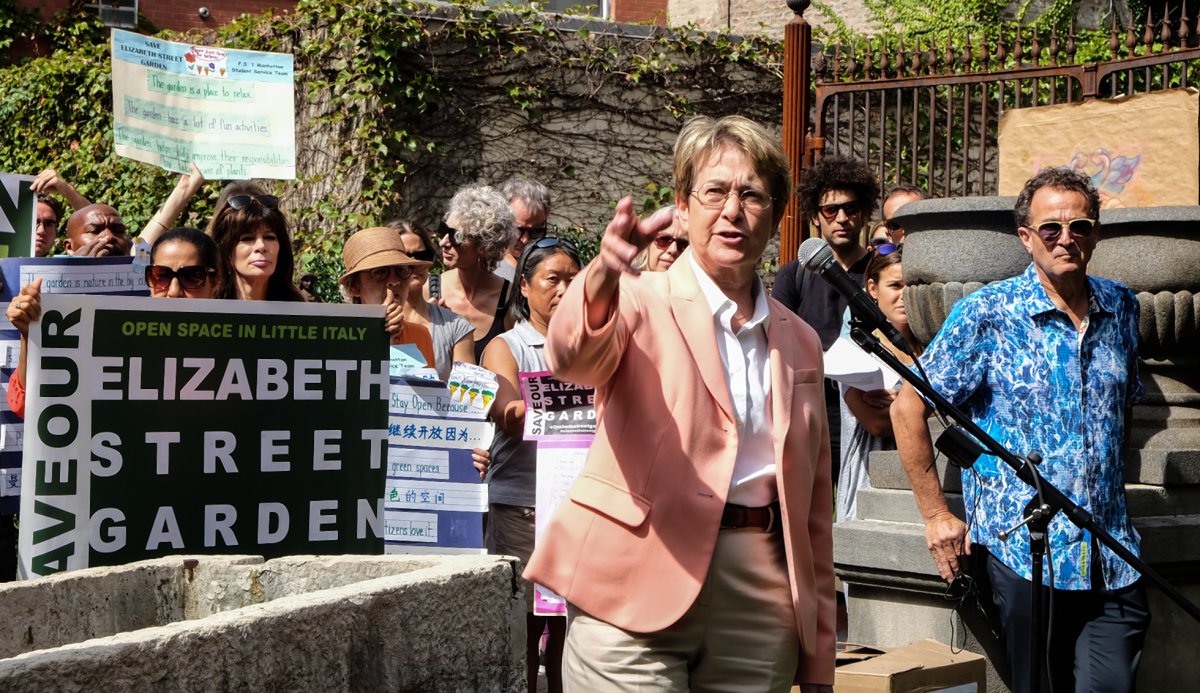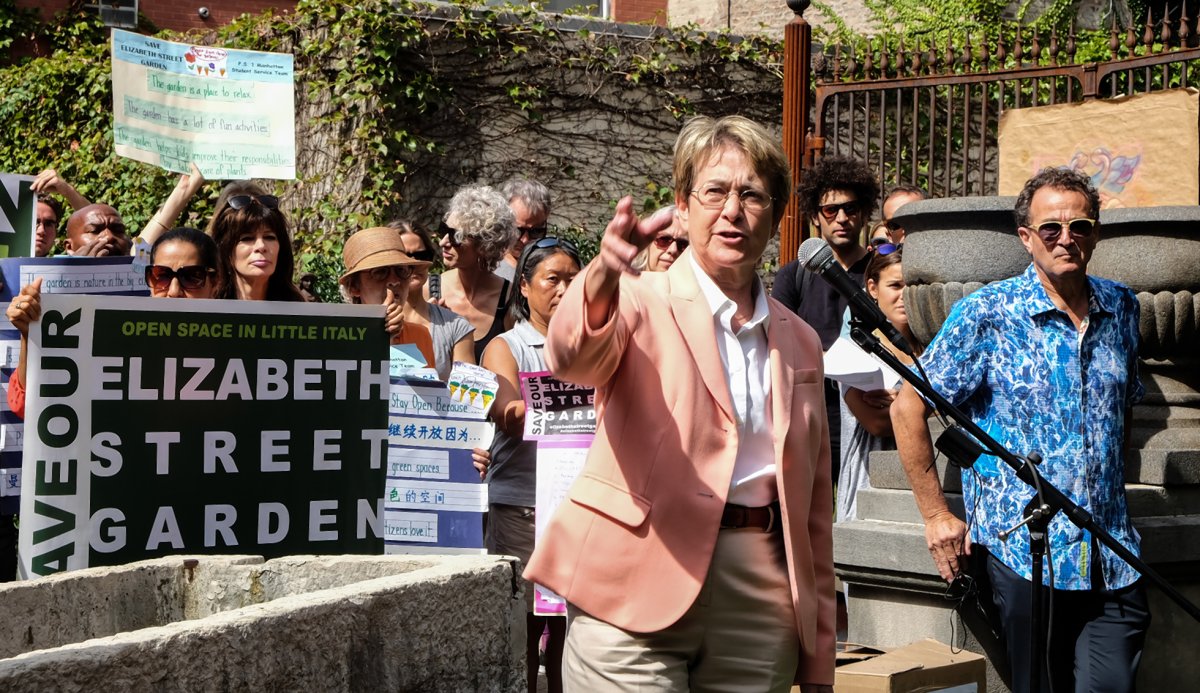
BY LINCOLN ANDERSON | The Elizabeth St. Garden’s two nonprofit organizations on Wednesday announced separate lawsuits to block a city-sponsored affordable-housing project from being built on the Little Italy green oasis.
It’s rare for legislators to be plaintiffs on community lawsuits, but Assemblymembers Deborah Glick and Yuh-Line Niou are co-plaintiffs on one of them.
Elizabeth St. Garden, the group that currently operates the roughly 20,000-square-foot space, filed its lawsuit early Tuesday evening and publicly announced it on Wednesday.
The other group, Friends of Elizabeth St. Garden, which first activated the garden five years ago as a real community space, announced its own lawsuit Wednesday, but it wasn’t immediately clear if it had been filed yet.
“This is an Article 78 lawsuit against the City of New York and the Department of Housing Preservation and Development,” said Joseph Reiver, executive director of Elizabeth St. Garden. An Article 78 is basically a challenge of a decision by the city or one of its agencies.
Reiver has an affidavit in the lawsuit, as does Adrian Benepe, New York City’s former Parks Department commissioner, who is a champion of the garden. There is also an affidavit by an environmental consultant, saying why the project, as construed, would have a negative environmental impact on this corner of Little Italy, which suffers from a lack of green space.
The plaintiffs in the lawsuit include Allan Reiver, Joseph’s father and the person who created the garden, and Renee Green, an E.S.G. board member. Green, who is a senior with limited mobility, values the garden as a therapeutic refuge within easy walking distance for her.
Allan Reiver, who operates a gallery in a building he owns just north of the garden lot, has held a lease from the city for the outdoor space since 1991, renting it for $4,000 a month.
As the senior Reiver, who is in his mid-70s, told The Villager back in October 2015, when he first arrived on the block in 1989, he lived across the street from the then-garbage-strewn vacant lot, and — sick of looking at the eyesore every day — resolved to clean it up. After getting approval from Community Board 2 and the city, he landscaped the spot and added statues and monuments that he had collected from estates. He sold two or three of the sculptures per year, but said the sales were just incidental — that he really just intended to beautify the block, and by extension, the surrounding neighborhood.
Joseph Reiver said the thrust of their lawsuit is simple: They are challenging the city’s finding of a “negative declaration,” that a full environmental impact statement, or E.I.S., was not required for the project because it would have no significant environmental impact
“They need to enjoin from planning, developing or doing anything on this project until the city has fulfilled its obligations under SEQRA and CEQR, and as part of that, doing a full E.I.S,” he said.
SEQRA refers to the State Environmental Quality Review Act and CEQR is the City Environmental Quality Review.
Reiver said their lawyer, Norman Siegel, and F.E.S.G.’s lawyer, Michael Gruen, “were coordinating up until a few days ago.”
Asked how the lawsuits compare, he said, “I’m sure a lot of the arguments will be redundant — or reinforced.”
E.S.G. has posted all of its legal papers online at https://www.elizabethstreetgarden.com/legal .
Meanwhile, Glick and Niou are co-plaintiffs on the lawsuit by the other group, F.E.S.G. Like the E.S.G. suit, it calls on the city to halt it current Uniform Land Use Review Procedure for project. ULURPs are required for the disposition of city-owned property.
“The suit seeks to stop the ULURP proceedings because the city acted illegally, issuing a ‘negative declaration’ claiming that there are no significant environmental impacts, brushing aside possible ground contamination from hazardous materials,” F.E.S.G.’s press release announcing the lawsuit states.
The F.E.S.G. suit also asserts that the finding by H.P.D. that the beautiful garden is “blighted” is invalid.

Additionally, the suit notes, “The property is subject to a declaration — that it may be used solely for educational purposes and that [the city must] hold the property in trust for the Board of Education.”
A public school formerly occupied the southern part of the block, and the current garden sits on what used to be the school’s playground. The school’s former location is today occupied by the LIRA affordable-housing complex.
Information about the F.E.S.G. lawsuit can be read in a newsletter on the group’s Web site at, https://mailchi.mp/elizabethstreetgarden/190306 .
In general, the area is starved for open space — in particular, green space — and the 20,000-square-foot park is open to the public year-round, offering more than 200 free public events annually and attracting more than 100,000 visitors each year, the release adds.
“The open public space within a half mile of the garden, including the garden, adds up to just 10 percent of what the city proclaims is the rock-bottom need for a residential area,” Michael Gruen, the attorney for F.E.S.G. “That makes even a small jewel a big symbol.”
“Elizabeth St. Garden is an oasis of open space, light and air in a community in Lower Manhattan that lacks equitable park space,” Glick said. “While the pursuit of building more affordable housing and senior housing in our communities is a noble goal, the city must work with local residents in a transparent process to find equitable solutions that will produce the most good in our neighborhoods. That includes ensuring that when a community finds alternative and more appropriate sites for affordable housing, the city does not simply disregard those efforts because it is easier to build on a site that happens to be a community garden.
“I am happy to be a co-plaintiff in this lawsuit and feel strongly, as I have advocated in the past, that if the community adopts an open space as a park, it should remain a park.”
“Our community stepped up and created new open space when the city would not,” Niou said. “We engaged our community to develop Elizabeth St. Garden into a jewel which meets the needs of our community. Our community severely lacks green space. Lower Manhattan is in need of affordable housing, but we cannot pit the need for housing against the need for green space, especially when good alternatives are available. Both are vital and both are in dire need of protection and expansion.
“Together, we must evaluate the city’s decisions regarding Elizabeth St. Garden,” Niou said, “and work toward a community-based plan that provides proper attention to environmental impacts and addresses the need for affordable housing.”
“To destroy it, when there is a better alternative site, is not only bad city planning but also unconscionable” said Emily Hellstrom, of F.E.S.G. “The city has turned its back on our grassroots movement, but we will not back down in the face of this willful disregard.”
Added Jeannine Kiely, president of F.E.S.G., “The city has a win-win opportunity: Save the beloved garden — the only green space in our neighborhood — and build up to five times as much affordable housing at the nearby C.B. 2-supported alternative site, a city-owned gravel-filled lot at 388 Hudson St. In fact, the city announced a similar win-win swap in Chelsea, where it is creating a new park on W. 20th St. and building housing on a larger city-owned site two miles north.”
Helmstrom and Kiely are both plaintiffs on the suit, along with Kent Barwick, a former president of the Municipal Art Society.
The suits were filed now, according to Kiely, because a statute of limitations to do so from when the city certified the project was close to running out.
As opposed to Glick and Niou — and, for the matter, almost all of the area’s other local politicians — City Councilmember Margaret Chin has staunchly backed the Haven Green project. Chin was the key player, in fact, in identifying the Little Italy garden site for affordable housing after being unable to secure 100 percent affordable housing in the Seward Park Urban Renewal Area project near the Williamsburg Bridge. The SPURA site, where Essex Crossing is now being developed, is actually located in a different community board than the garden — Community Board 3.
The lone other local elected official backing Haven Green is Manhattan Borough President Gale Brewer, who recently approved it as part of ULURP.
Asked for comment on the lawsuits, a spokesperson for the Haven Green development team provided a statement, which noted that the affordable-housing project — which would be for seniors — is slated for one of the city’s “most gentrified” neighborhoods.
“The development team is aware of the lawsuits against the city and stands firmly behind the vision of Haven Green to bring deeply affordable, L.G.B.T.Q.-friendly, senior housing to one of New York’s most gentrified and high-opportunity neighborhoods,” the statement said. “The Haven Green project itself is a model energy-efficient building, adhering to passive-house standards, employing significant sustainability measures, a green roof and a rainwater-collection system. As proven, responsible stewards of public land and community assets, the Haven Green development team partners support H.P.D. in their use of city-owned land to create critical affordable housing for low-income seniors and public green space for the community.”
Particularly galling to the garden groups is that Habitat for Humanity NYC would have office space in the project.




































